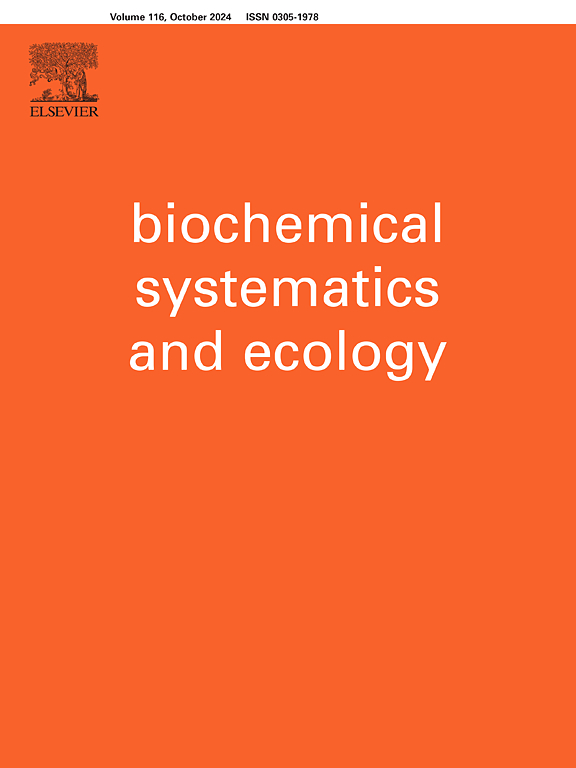柑桔精油的化学成分及生态生物活性研究
IF 2
4区 生物学
Q4 BIOCHEMISTRY & MOLECULAR BIOLOGY
引用次数: 0
摘要
本研究的目的是研究突尼斯柑橘精油的化学成分和多方面的生物活性。GC-MS分析结果表明,柠檬烯含量为88.1%。抗自由基试验显示出显著的潜力,IC50值分别为25.14 μg/mL (DPPH)和7.58 μg/mL (ABTS)。该精油对金黄色葡萄球菌和铜绿假单胞菌具有良好的抑菌活性,最低抑菌浓度(MIC)在1.08 ~ 8.75 mg/mL之间,具有良好的抗凝血性能。对castaneum的杀虫试验表明,在200 μL的剂量下,其死亡率为80%,驱避效果最小。精油的化感作用对萝卜和莴苣的种子萌发和根系生长有明显的抑制作用。分子对接发现,通过与HPPD受体的有效结合,反式柠檬烯氧化物和香芹酮是有前途的除草剂。该研究结果表明,紫荆挥发油在害虫防治、杂草防治以及食品和制药工业中具有潜在的应用价值。本文章由计算机程序翻译,如有差异,请以英文原文为准。
Chemical composition and ecological bioactivity of Citrus sinensis essential oil
The objective of this study is to investigate the chemical composition and multifaceted biological activities of Tunisian Citrus sinensis L. essential oil. The results of the GC–MS analysis indicated that limonene constituted 88.1 % of the oil. Antiradical tests demonstrated notable potential, with IC50 values of 25.14 μg/mL (DPPH) and 7.58 μg/mL (ABTS). The essential oil demonstrated antibacterial activity against multidrug-resistant strains of Staphylococcus aureus and Pseudomonas aeruginosa, with minimum inhibitory concentration (MIC) values ranging from 1.08 to 8.75 mg/mL, and exhibited effective anticoagulant properties. Insecticidal tests against Tribolium castaneum indicated a mortality rate of 80 % at a dosage of 200 μL, with minimal repellent effects. The allelopathic activity of the essential oil was found to significantly inhibit seed germination and root growth in radish and lettuce. Molecular docking identified trans-limonene oxide and carvone as promising herbicidal agents through effective binding to the HPPD receptor. The findings suggest that C. sinensis essential oil has potential applications in pest management, weed control, and the food and pharmaceutical industries.
求助全文
通过发布文献求助,成功后即可免费获取论文全文。
去求助
来源期刊

Biochemical Systematics and Ecology
生物-进化生物学
CiteScore
3.00
自引率
12.50%
发文量
147
审稿时长
43 days
期刊介绍:
Biochemical Systematics and Ecology is devoted to the publication of original papers and reviews, both submitted and invited, in two subject areas: I) the application of biochemistry to problems relating to systematic biology of organisms (biochemical systematics); II) the role of biochemistry in interactions between organisms or between an organism and its environment (biochemical ecology).
In the Biochemical Systematics subject area, comparative studies of the distribution of (secondary) metabolites within a wider taxon (e.g. genus or family) are welcome. Comparative studies, encompassing multiple accessions of each of the taxa within their distribution are particularly encouraged. Welcome are also studies combining classical chemosystematic studies (such as comparative HPLC-MS or GC-MS investigations) with (macro-) molecular phylogenetic studies. Studies that involve the comparative use of compounds to help differentiate among species such as adulterants or substitutes that illustrate the applied use of chemosystematics are welcome. In contrast, studies solely employing macromolecular phylogenetic techniques (gene sequences, RAPD studies etc.) will be considered out of scope. Discouraged are manuscripts that report known or new compounds from a single source taxon without addressing a systematic hypothesis. Also considered out of scope are studies using outdated and hard to reproduce macromolecular techniques such as RAPDs in combination with standard chemosystematic techniques such as GC-FID and GC-MS.
 求助内容:
求助内容: 应助结果提醒方式:
应助结果提醒方式:


